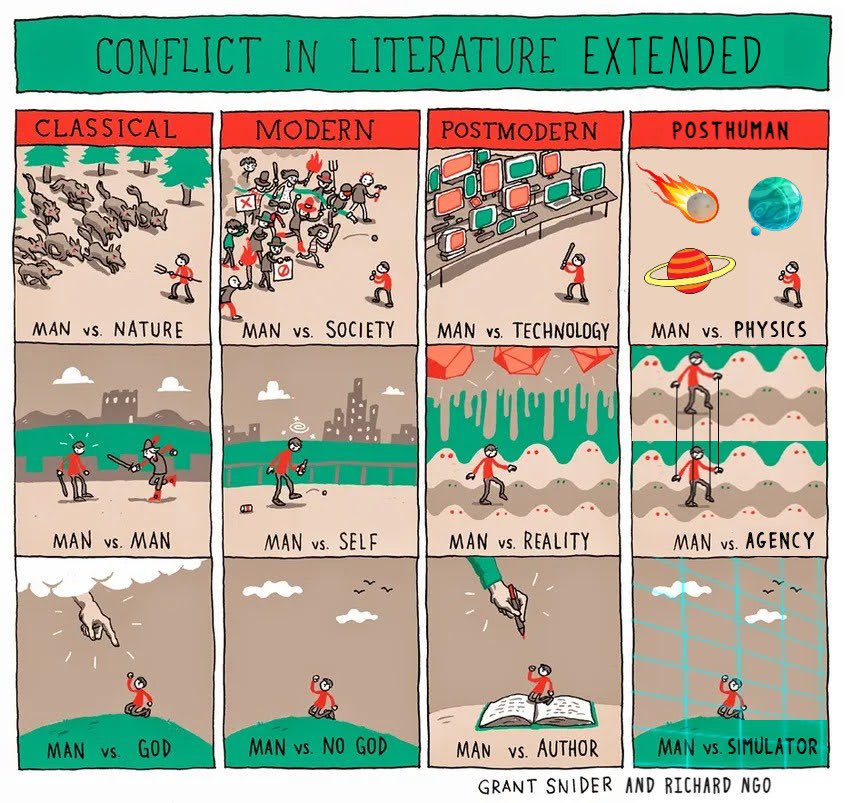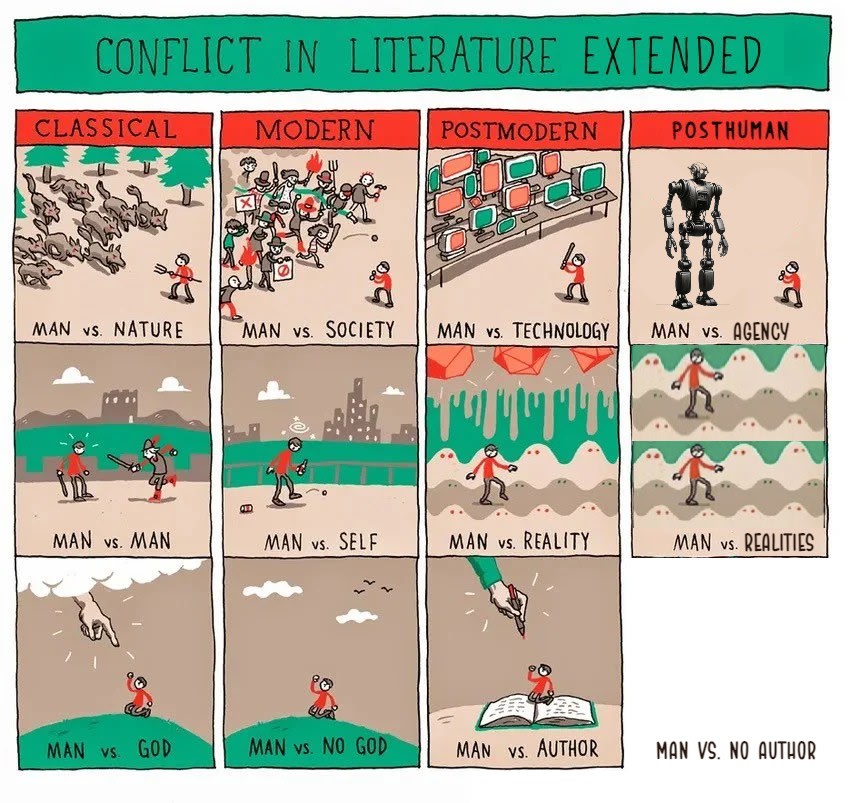Conflict in Posthuman Literature
post by Martín Soto (martinsq) · 2024-04-06T22:26:04.051Z · LW · GW · 1 commentsThis is a link post for https://twitter.com/MotionTsar/status/1776726715311767913
Contents
1 comment
Grant Snider created this comic (which became a meme):

Richard Ngo extended it into posthuman=transhumanist literature:

That's cool, but I'd have gone for different categories myself.[1]
Here they are together with their explanations.

Top: Man vs Agency
(Other names: Superintelligence, Singularity, Self-improving technology, Embodied consequentialism.)
Because Nature creates Society creates Technology creates Agency.
At each step Man becomes less in control, due to his increased computational boundedness relative to the other.
Middle: Man vs Realities
(Other names: Simulation, Partial existence, Solomonoff prior, Math.)
Because
- Man vs Self is the result of dissolving holistic individualism (no subagents in conflict) from Man vs Man.
- Man vs Reality is the result of dissolving the Self boundary altogether from Man vs Self.
- Man vs Realities is the result of dissolving the binary boundary between existence and non-existence from Man vs Reality. Or equivalently, the boundary between different physical instantiations of you (noticing you are your mathematical algorithm).
At each step a personal identity boundary previously perceived as sharp is dissolved.[2]
Bottom: Man vs No Author
(Other names: Dust theory, Groundlessness, Meaninglessness, Relativism, Extreme functionalism, Philosophical ill-definedness, Complete breakdown of abstractions and idealizations, .)
Because
- Man vs God thinks "the existence of idealization (=Platonic realm=ultimate meaning=unstoppable force)" is True. This corresponds to philosophical idealism.
- Man vs No God notices "the existence of idealization" is False. And scorns Man vs God's wishful beliefs. This corresponds to philosophical materialism.
- Man vs Author notices "the existence of idealization" is not a well-defined question (doesn't have a truth value). And voices this realization, scorning the still-idealistic undertone of Man vs No God, by presenting itself as mock-idealization (Author) inside the shaky boundaries (breaking the fourth wall) of a non-idealized medium (literature, language). This corresponds to the Vienna circle, Quine's Web of Belief, Carnap's attempt at metaphysical collapse and absolute language, an absolute and pragmatic grounding for sensorial reality.
- Man vs No Author notices that the realization of Man vs Author cannot really be expressed in any language, cannot be voiced, and we must remain silent. It notices there never was any "noticing". One might hypothesize it would scorn Man vs Author if it could, but it has no voice to do so. It is cessation of conflict, breakdown of literature. This corresponds to early Wittgenstein, or Rorty's Pan-Relationalism.
At each step the implicit philosophical presumptions of the previous paradigm are revealed untenable.
The vertical gradient is also nice:
- The first row presents ever-more-advanced macroscopic events in reality, derived through physics as causal consequences.
- The second row presents ever-more-general realizations about our nature, derived through maths as acausal influence our actions have in reality.[3]
- The third row presents ever-more-destructive collapses of the implicit theoretical edifice we use to relate our nature with reality, derived through philosophy as different static impossibilities.
- ^
If I had to critique Richard's additions:
Man vs Physics seems too literal (in sci-fi stories the only remaining obstacle is optimizing physics), and not a natural extension of the literary evolution in that row.
Man vs Agency doesn't seem to me to capture the dance of boundaries that seems most interesting in that row.
Man vs Simulator seems again a too literal translation of Man vs Author (changing the flavor of the setting rather than the underlying idea).
- ^
To see the Man vs Man to Man vs Self transition as a dissolution of a sharp boundary, consider that previously you thought all your subagents were working in perfect unison, each doing their exact part without questioning the pre-set boundaries, while now you notice that sometimes they enter conflict and try to move the boundaries.
- ^
To see the Man vs Man to Man vs Self transition as newly discovered acausal influence, consider it as the realization that your actions give you information about your subagents' behavior, not only that of your whole algorithm.
1 comments
Comments sorted by top scores.
comment by Filip Sondej · 2024-04-07T09:11:49.042Z · LW(p) · GW(p)
I wanna link to my favorite one: consciousness vs replicators. It doesn't really fit into this grid, but I think it really is the ultimate conflict.
(You can definitely skip the first 14 min of this video, as it's just ranking people's stages of development. Maybe even first 33 min if you wanna go straight to the point.)